Regional Differences and Dynamic Evolution of Carbon Emission Intensity of Agriculture Production in China
Abstract
1. Introduction
2. Methodologies
2.1. Measuring Agricultural Carbon Emissions
2.2. The Theil Index
2.3. The Global Spatial Auto-Correlation
2.4. Hot and Cold Spot Analysis
2.5. Data Source
3. Regional Differences in China’s Carbon Emissions from Agricultural Production
3.1. Overall Difference Analysis
3.2. Analysis of Intra-Regional Difference
3.3. Cause Analysis of Regional Differences
4. Spatial Pattern Evolution
4.1. Spatial and Temporal Sequence Analysis of Agricultural Carbon Emission Intensity
4.2. Global Pattern Evolution
4.3. Hot and Cold Spot Analysis
5. Conclusions
Author Contributions
Funding
Acknowledgments
Conflicts of Interest
References
- Zhang, Y.-J.; Peng, Y.-L.; Ma, C.-Q.; Shen, B. Can environmental innovation facilitate carbon emissions reduction? Evidence from China. Energy Policy 2017, 100, 18–28. [Google Scholar] [CrossRef]
- Mi, Z.; Meng, J.; Guan, D.; Shan, Y.; Song, M.; Wei, Y.-M.; Liu, Z.; Hubacek, K. Chinese CO2 emission flows have reversed since the global financial crisis. Nat. Commun. 2017, 8, 1712. [Google Scholar] [CrossRef] [PubMed]
- Shi, K.; Chen, Y.; Yu, B.; Xu, T.; Chen, Z.; Liu, R.; Li, L.; Wu, J. Modeling spatiotemporal CO2 (carbon dioxide) emission dynamics in China from DMSP-OLS nighttime stable light data using panel data analysis. Appl. Energy 2016, 168, 523–533. [Google Scholar] [CrossRef]
- Chen, X.; Shuai, C.; Wu, Y.; Zhang, Y. Analysis on the carbon emission peaks of China’s industrial, building, transport, and agricultural sectors. Sci. Total. Environ. 2020, 709, 135768. [Google Scholar] [CrossRef]
- Zheng, X.; Lu, Y.; Yuan, J.; Baninla, Y.; Zhang, S.; Stenseth, N.C.; Hessen, D.O.; Tian, H.; Obersteiner, M.; Chen, D. Drivers of change in China’s energy-related CO2emissions. Proc. Natl. Acad. Sci. USA 2019, 117, 29–36. [Google Scholar] [CrossRef] [PubMed]
- Wang, H.; Lu, X.; Deng, Y.; Sun, Y.; Nielsen, C.P.; Liu, Y.; Zhu, G.; Bu, M.; Bi, J.; McElroy, M.B. China’s CO2 peak before 2030 implied from characteristics and growth of cities. Nat. Sustain. 2019, 2, 748–754. [Google Scholar] [CrossRef]
- Robertson, G.P.; Paul, E.A.; Harwood, R.R. Greenhouse Gases in Intensive Agriculture: Contributions of Individual Gases to the Radiative Forcing of the Atmosphere. Science 2000, 289, 1922–1925. [Google Scholar] [CrossRef] [PubMed]
- Schneider, U.A.; McCarl, B.A.; Schmid, E. Agricultural sector analysis on greenhouse gas mitigation in US agriculture and forestry. Agric. Syst. 2007, 94, 128–140. [Google Scholar] [CrossRef]
- Lamb, A.; Green, R.; Bateman, I.; Broadmeadow, M.; Bruce, T.; Burney, J.; Carey, P.; Chadwick, D.; Crane, E.; Field, R.; et al. The potential for land sparing to offset greenhouse gas emissions from agriculture. Nat. Clim. Chang. 2016, 6, 488–492. [Google Scholar] [CrossRef]
- Pellerin, S.; Bamière, L.; Angers, D.; Béline, F.; Benoit, M.; Butault, J.-P.; Chenu, C.; Colnenne-David, C.; De Cara, S.; Delame, N.; et al. Identifying cost-competitive greenhouse gas mitigation potential of French agriculture. Environ. Sci. Policy 2017, 77, 130–139. [Google Scholar] [CrossRef]
- Frank, S.; Havlík, P.; Stehfest, E.; Van Meijl, H.; Witzke, P.; Pérez-Domínguez, I.; Van Dijk, M.; Doelman, J.C.; Fellmann, T.; Koopman, J.F.L.; et al. Agricultural non-CO2 emission reduction potential in the context of the 1.5 °C target. Nat. Clim. Chang. 2018, 9, 66–72. [Google Scholar] [CrossRef]
- Cheng, K.; Pan, G.; Smith, P.; Luo, T.; Li, L.; Zheng, J.; Zhang, X.; Han, X.; Yan, M. Carbon footprint of China’s crop production-An estimation using agro-statistics data over 1993–2007. Agric. Ecosyst Environ. 2011, 142, 231–237. [Google Scholar] [CrossRef]
- Huang, X.; Xu, X.; Wang, Q.; Zhang, L.; Gao, X.; Chen, L. Assessment of Agricultural Carbon Emissions and Their Spatiotemporal Changes in China, 1997-2016. Int. J. Environ. Res. Public Health 2019, 16, 3105. [Google Scholar] [CrossRef] [PubMed]
- Bai, Y.; Deng, X.; Jiang, S.; Zhao, Z.; Miao, Y. Relationship between climate change and low-carbon agricultural production: A case study in Hebei Province, China. Ecol. Indic. 2019, 105, 438–447. [Google Scholar] [CrossRef]
- Nayak, D.; Saetnan, E.; Cheng, K.; Wang, W.; Koslowski, F.; Cheng, Y.-F.; Zhu, W.Y.; Wang, J.-K.; Liu, J.-X.; Moran, D.; et al. Management opportunities to mitigate greenhouse gas emissions from Chinese agriculture. Agric. Ecosyst. Environ. 2015, 209, 108–124. [Google Scholar] [CrossRef]
- Wang, W.; Koslowski, F.; Nayak, D.R.; Smith, P.; Saetnan, E.; Ju, X.; Guo, L.; Han, G.; De Perthuis, C.; Lin, E.; et al. Greenhouse gas mitigation in Chinese agriculture: Distinguishing technical and economic potentials. Glob. Environ. Chang. 2014, 26, 53–62. [Google Scholar] [CrossRef]
- Cai, T.; Xia, F.; Yang, D.; Huo, J.; Zhang, Y. Decomposition of factors affecting changes in non-CO2 greenhouse gas emission intensity of China’s livestock sector based on the concept of “environment–food–economy”. Sci. Total. Environ. 2019, 691, 611–620. [Google Scholar] [CrossRef]
- Xiong, C.; Chen, S.; Xu, L. Driving factors analysis of agricultural carbon emissions based on extended STIRPAT model of Jiangsu Province, China. Growth Chang. 2020, 51, 1401–1416. [Google Scholar] [CrossRef]
- Chen, Y.; Li, M.; Su, K.; Li, X. Spatial-Temporal Characteristics of the Driving Factors of Agricultural Carbon Emissions: Empirical Evidence from Fujian, China. Energies 2019, 12, 3102. [Google Scholar] [CrossRef]
- Gan, Y.; Liang, C.; Chai, Q.; Lemke, R.L.; Campbell, C.A.; Zentner, R.P. Improving farming practices reduces the carbon footprint of spring wheat production. Nat. Commun. 2014, 5, 5012. [Google Scholar] [CrossRef]
- Luo, Y.; Long, X.; Wu, C.; Zhang, J. Decoupling CO2 emissions from economic growth in agricultural sector across 30 Chinese provinces from 1997 to 2014. J. Clean. Prod. 2017, 159, 220–228. [Google Scholar] [CrossRef]
- Tian, Y.; Zhang, J.; He, Y.-Y. Research on Spatial-Temporal Characteristics and Driving Factor of Agricultural Carbon Emissions in China. J. Integr. Agric. 2014, 13, 1393–1403. [Google Scholar] [CrossRef]
- Bell, M.; Cloy, J.M.; Rees, R.M. The true extent of agriculture’s contribution to national greenhouse gas emissions. Environ. Sci. Policy 2014, 39, 1–12. [Google Scholar] [CrossRef]
- Zafeiriou, E.; Azam, M. CO2 emissions and economic performance in EU agriculture: Some evidence from Mediterranean countries. Ecol. Indic. 2017, 81, 104–114. [Google Scholar] [CrossRef]
- West, T.O.; Marland, G. A synthesis of carbon sequestration, carbon emissions, and net carbon flux in agriculture: Comparing tillage practices in the United States. Agric. Ecosyst. Environ. 2002, 91, 217–232. [Google Scholar] [CrossRef]
- IPCC. Available online: www.ipcc.ch/about/preparingreports/ (accessed on 16 October 2020).
- Zhang, L.; Pang, J.; Chen, X.; Lu, Z. Carbon emissions, energy consumption and economic growth: Evidence from the agricultural sector of China’s main grain-producing areas. Sci. Total. Environ. 2019, 665, 1017–1025. [Google Scholar] [CrossRef]
- Wang, H.; Zhou, P. Assessing Global CO2 Emission Inequality From Consumption Perspective: An Index Decomposition Analysis. Ecol. Econ. 2018, 154, 257–271. [Google Scholar] [CrossRef]
- Malakar, K.; Mishra, T.; Patwardhan, A. Inequality in water supply in India: An assessment using the Gini and Theil indices. Environ. Dev. Sustain. 2017, 20, 841–864. [Google Scholar] [CrossRef]
- Bickenbach, F.; Liu, W.-H.; Nunnenkamp, P. Regional concentration of FDI in post-reform India: A district-level analysis. J. Int. Trade Econ. Dev. 2014, 24, 660–695. [Google Scholar] [CrossRef][Green Version]
- Pang, J.; Chen, X.; Zhang, Z.; Li, H. Measuring Eco-Efficiency of Agriculture in China. Sustainability 2016, 8, 398. [Google Scholar] [CrossRef]
- Liu, X.-Z.; Yang, X.; Guo, R. Regional Differences in Fossil Energy-Related Carbon Emissions in China’s Eight Economic Regions: Based on the Theil Index and PLS-VIP Method. Sustainability 2020, 12, 2576. [Google Scholar] [CrossRef]
- Wang, X.-X.; He, A.-Z.; Zhao, J. Regional disparity and dynamic evolution of carbon emission reduction maturity in China’s service industry. J. Clean. Prod. 2020, 244, 118926. [Google Scholar] [CrossRef]
- Getis, A. Reflections on spatial autocorrelation. Reg. Sci. Urban. Econ. 2007, 37, 491–496. [Google Scholar] [CrossRef]
- Yang, J.; Zhang, Y.; Luo, L.; Meng, R.; Yu, C. Global Mortality Burden of Cirrhosis and Liver Cancer Attributable to Injection Drug Use, 1990–2016: An Age-Period-Cohort and Spatial Autocorrelation Analysis. Int. J. Environ. Res. Public Health 2018, 15, 170. [Google Scholar] [CrossRef]
- National Bureau of Statistics of the People’s Republic China. China Rural Statistical Yearbooks 1991–2018; China Statistical Press: Beijing, China, 1992–2019.
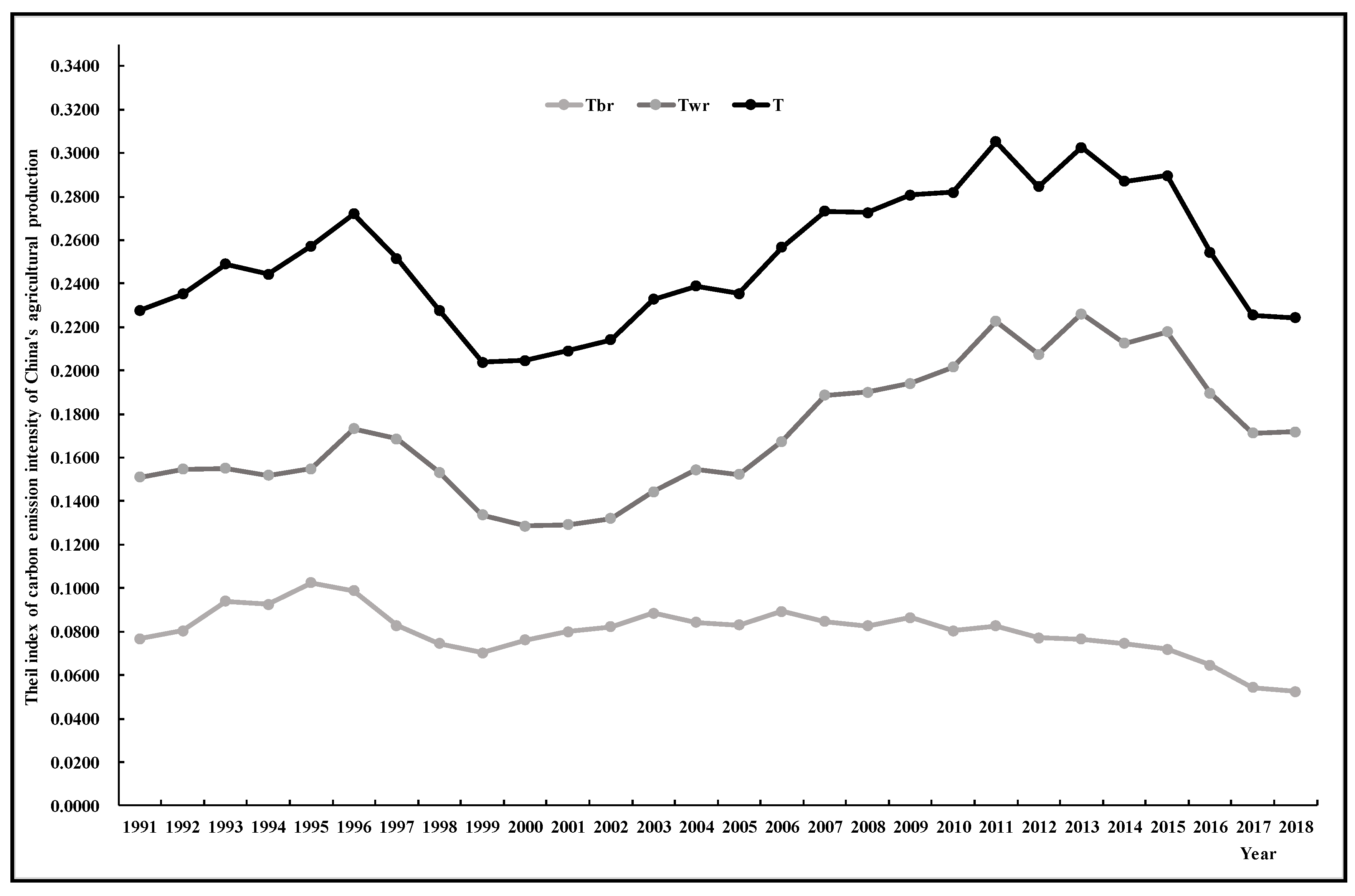
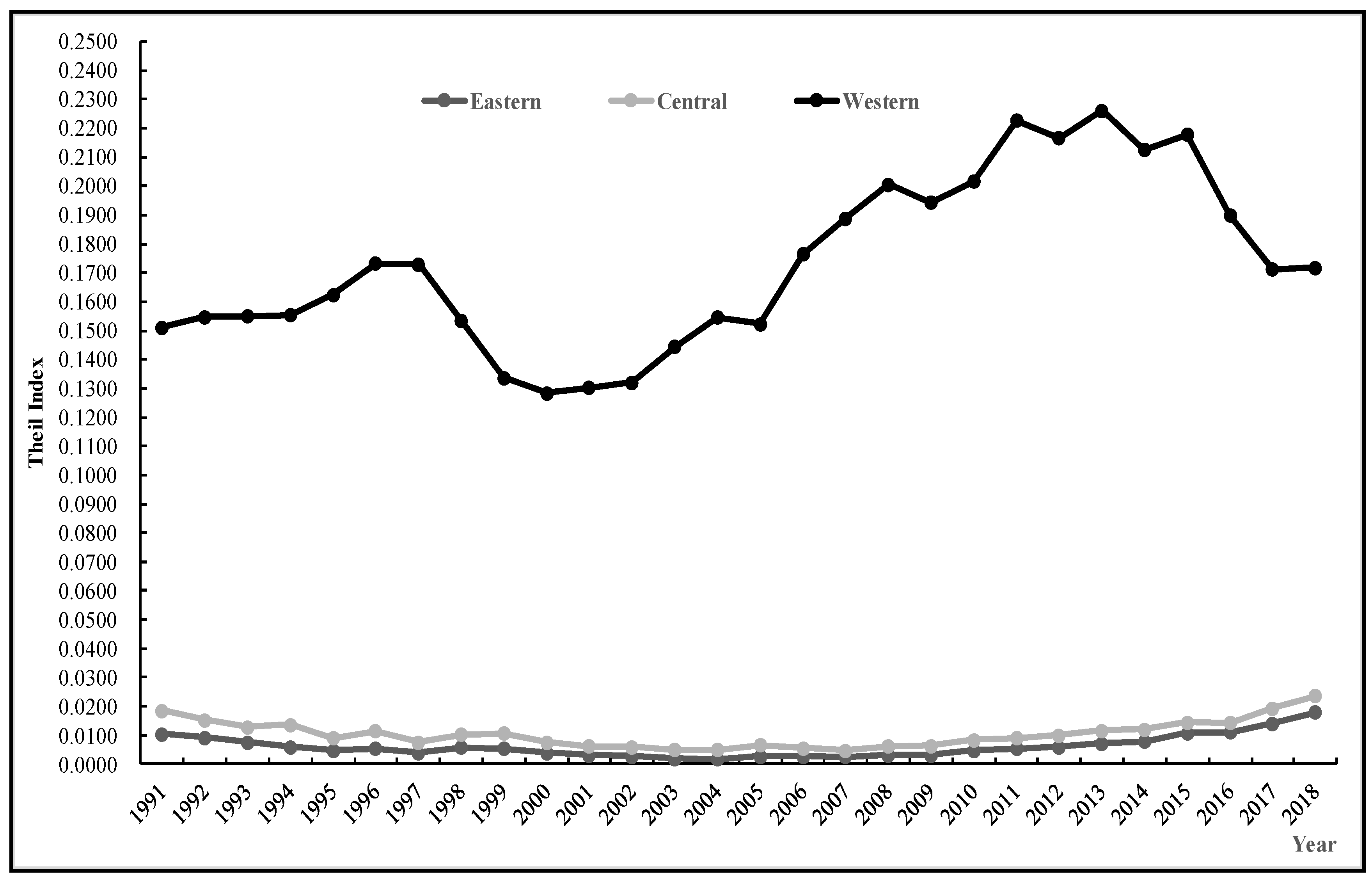
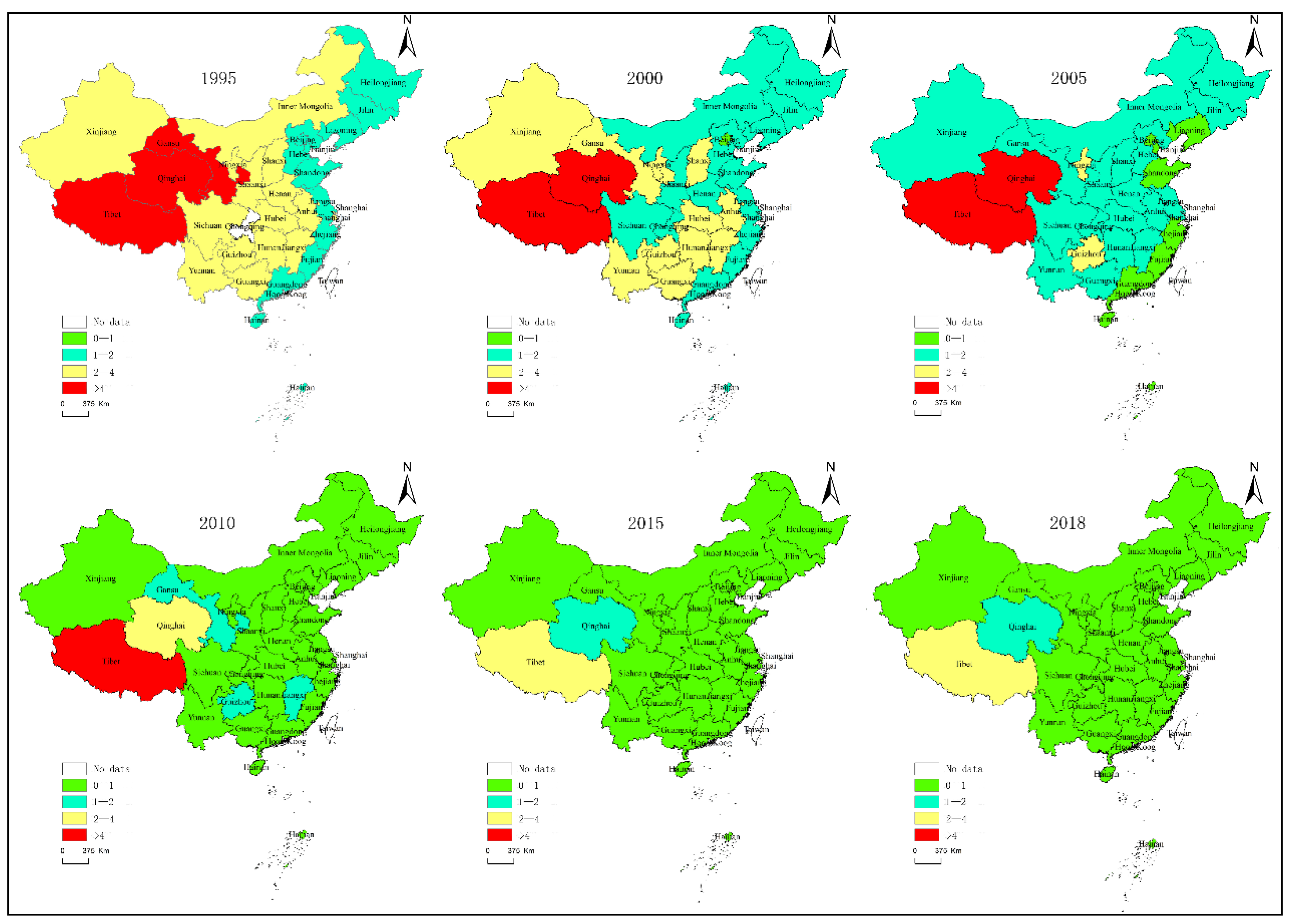
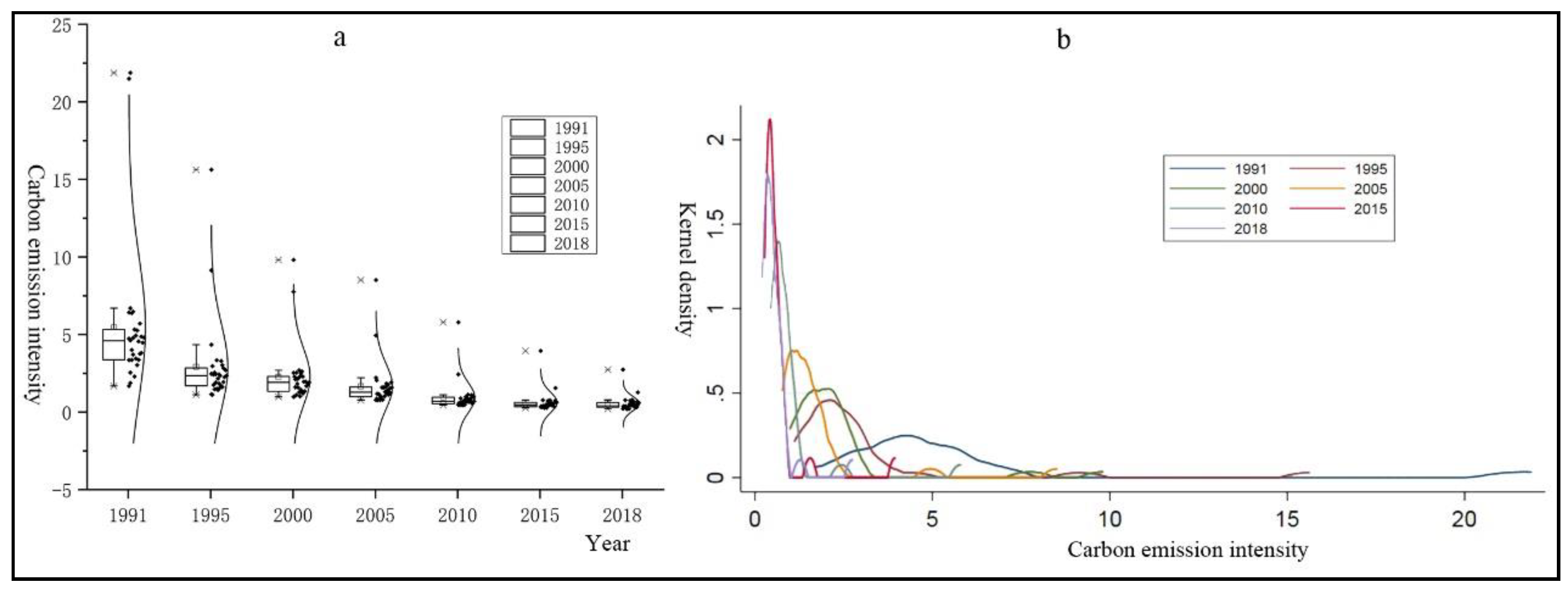
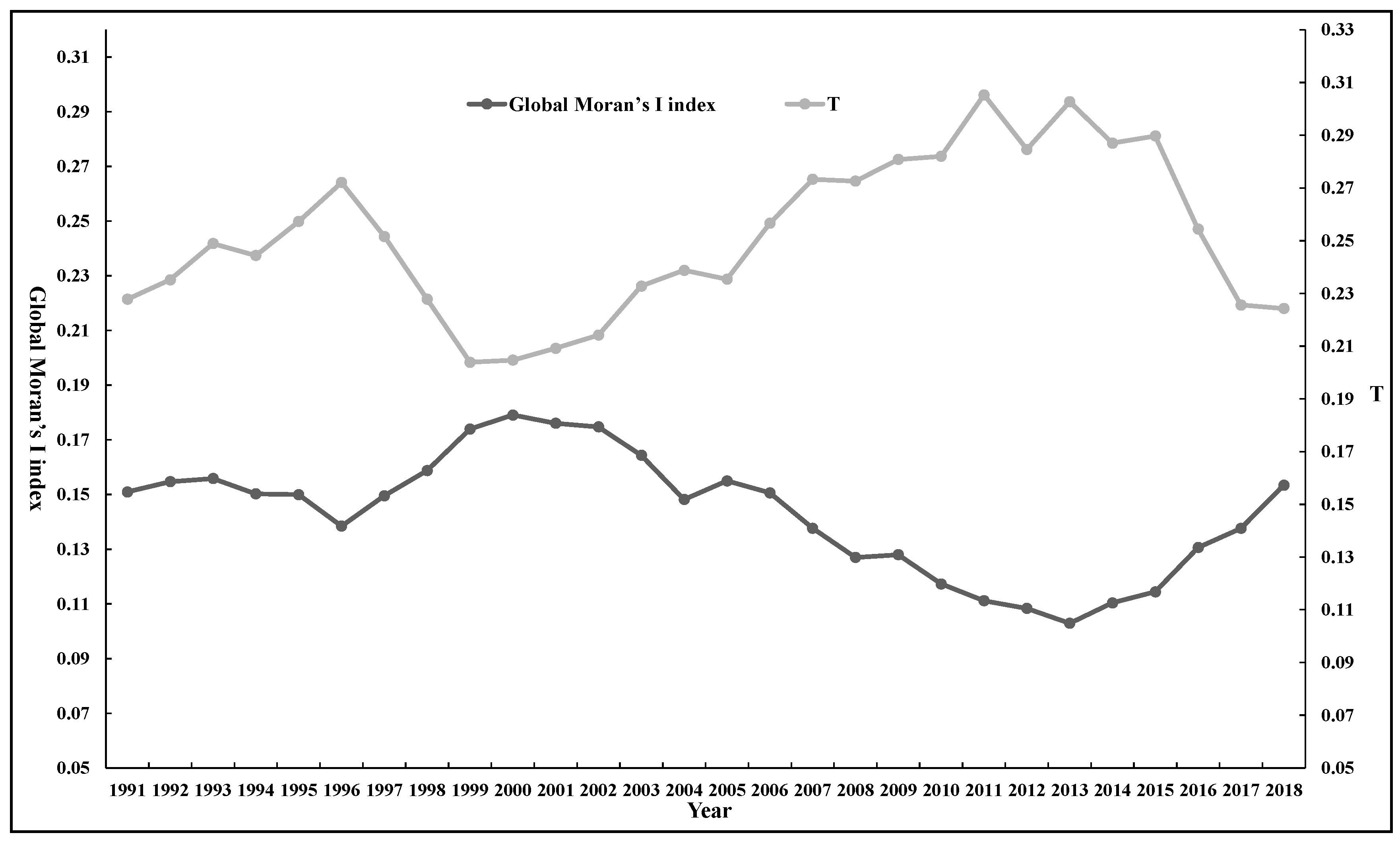

| Year | Tbr | Twr | T |
|---|---|---|---|
| 1991 | 0.0767 | 0.1510 | 0.2278 |
| 1992 | 0.0804 | 0.1547 | 0.2352 |
| 1994 | 0.0926 | 0.1518 | 0.2444 |
| 1995 | 0.1025 | 0.1548 | 0.2573 |
| 1996 | 0.0989 | 0.1733 | 0.2721 |
| 1997 | 0.0829 | 0.1687 | 0.2516 |
| 1998 | 0.0745 | 0.1533 | 0.2278 |
| 1999 | 0.0702 | 0.1337 | 0.2039 |
| 2000 | 0.0762 | 0.1285 | 0.2047 |
| 2001 | 0.0801 | 0.1291 | 0.2092 |
| 2002 | 0.0822 | 0.1321 | 0.2142 |
| 2003 | 0.0885 | 0.1444 | 0.2328 |
| 2004 | 0.0843 | 0.1546 | 0.2388 |
| 2005 | 0.0830 | 0.1523 | 0.2354 |
| 2006 | 0.0892 | 0.1674 | 0.2566 |
| 2007 | 0.0846 | 0.1888 | 0.2733 |
| 2008 | 0.0825 | 0.1901 | 0.2726 |
| 2009 | 0.0865 | 0.1942 | 0.2808 |
| 2010 | 0.0803 | 0.2017 | 0.2820 |
| 2011 | 0.0826 | 0.2227 | 0.3053 |
| 2012 | 0.0771 | 0.2075 | 0.2846 |
| 2013 | 0.0765 | 0.2262 | 0.3027 |
| 2014 | 0.0744 | 0.2126 | 0.2870 |
| 2015 | 0.0718 | 0.2179 | 0.2897 |
| 2016 | 0.0647 | 0.1898 | 0.2544 |
| 2017 | 0.0544 | 0.1712 | 0.2256 |
| 2018 | 0.0524 | 0.1719 | 0.2243 |
| Year | Eastern | Central | Western |
|---|---|---|---|
| 1991 | 0.0105 | 0.0080 | 0.1325 |
| 1992 | 0.0092 | 0.0060 | 0.1395 |
| 1993 | 0.0077 | 0.0052 | 0.1421 |
| 1994 | 0.0059 | 0.0078 | 0.1416 |
| 1995 | 0.0048 | 0.0042 | 0.1534 |
| 1996 | 0.0054 | 0.0061 | 0.1618 |
| 1997 | 0.0039 | 0.0037 | 0.1654 |
| 1998 | 0.0057 | 0.0045 | 0.1430 |
| 1999 | 0.0054 | 0.0052 | 0.1231 |
| 2000 | 0.0040 | 0.0035 | 0.1210 |
| 2001 | 0.0032 | 0.0030 | 0.1240 |
| 2002 | 0.0026 | 0.0033 | 0.1261 |
| 2003 | 0.0020 | 0.0030 | 0.1394 |
| 2004 | 0.0018 | 0.0033 | 0.1495 |
| 2005 | 0.0027 | 0.0039 | 0.1457 |
| 2006 | 0.0028 | 0.0029 | 0.1707 |
| 2007 | 0.0026 | 0.0021 | 0.1840 |
| 2008 | 0.0031 | 0.0031 | 0.1943 |
| 2009 | 0.0031 | 0.0032 | 0.1879 |
| 2010 | 0.0048 | 0.0037 | 0.1932 |
| 2011 | 0.0054 | 0.0037 | 0.2136 |
| 2012 | 0.0060 | 0.0039 | 0.2066 |
| 2013 | 0.0071 | 0.0045 | 0.2146 |
| 2014 | 0.0078 | 0.0042 | 0.2005 |
| 2015 | 0.0108 | 0.0038 | 0.2033 |
| 2016 | 0.0110 | 0.0032 | 0.1756 |
| 2017 | 0.0140 | 0.0053 | 0.1519 |
| 2018 | 0.0180 | 0.0056 | 0.1483 |
| Year | Intra-Regional (%) | Inter-Regional (%) | Intra-Regional (%) | ||
|---|---|---|---|---|---|
| Eastern | Central | Western | |||
| 1991 | 4.62 | 3.51 | 58.18 | 33.68 | 66.30 |
| 1992 | 3.92 | 2.54 | 59.34 | 34.20 | 65.80 |
| 1993 | 3.08 | 2.10 | 57.09 | 37.74 | 62.26 |
| 1994 | 2.41 | 3.20 | 57.95 | 37.88 | 62.11 |
| 1995 | 1.88 | 1.62 | 59.61 | 39.85 | 60.16 |
| 1996 | 1.97 | 2.23 | 59.47 | 36.33 | 63.67 |
| 1997 | 1.56 | 1.49 | 65.73 | 32.95 | 67.05 |
| 1998 | 2.50 | 2.00 | 62.78 | 32.72 | 67.28 |
| 1999 | 2.65 | 2.55 | 60.38 | 34.43 | 65.57 |
| 2000 | 1.96 | 1.71 | 59.09 | 37.23 | 62.77 |
| 2001 | 1.54 | 1.45 | 59.29 | 38.28 | 61.71 |
| 2002 | 1.23 | 1.55 | 58.88 | 38.35 | 61.65 |
| 2003 | 0.86 | 1.29 | 59.86 | 38.00 | 62.01 |
| 2004 | 0.74 | 1.36 | 62.61 | 35.28 | 64.72 |
| 2005 | 1.13 | 1.67 | 61.91 | 35.28 | 64.72 |
| 2006 | 1.08 | 1.11 | 66.54 | 34.77 | 65.24 |
| 2007 | 0.95 | 0.78 | 67.33 | 30.94 | 69.06 |
| 2008 | 1.14 | 1.13 | 71.28 | 30.27 | 69.74 |
| 2009 | 1.12 | 1.15 | 66.92 | 30.82 | 69.18 |
| 2010 | 1.69 | 1.32 | 68.50 | 28.48 | 71.52 |
| 2011 | 1.75 | 1.21 | 69.98 | 27.06 | 72.94 |
| 2012 | 2.12 | 1.38 | 72.58 | 27.08 | 72.91 |
| 2013 | 2.34 | 1.48 | 70.90 | 25.28 | 74.72 |
| 2014 | 2.73 | 1.48 | 69.86 | 25.93 | 74.07 |
| 2015 | 3.72 | 1.30 | 70.19 | 24.79 | 75.21 |
| 2016 | 4.32 | 1.26 | 69.01 | 25.41 | 74.59 |
| 2017 | 6.20 | 2.35 | 67.35 | 24.10 | 75.90 |
| 2018 | 8.03 | 2.51 | 66.10 | 23.37 | 76.63 |
| Year | 1991 | 1992 | 1993 | 1994 | 1995 | 1996 | 1997 |
|---|---|---|---|---|---|---|---|
| MI | 0.151 *** | 0.155 *** | 0.156 *** | 0.150 *** | 0.150 *** | 0.138 *** | 0.150 *** |
| Z | 2.838 | 2.925 | 3.000 | 2.976 | 3.102 | 2.882 | 3.104 |
| Year | 1998 | 1999 | 2000 | 2001 | 2002 | 2003 | 2004 |
| MI | 0.159 *** | 0.174 *** | 0.179 *** | 0.176 *** | 0.175 *** | 0.164 *** | 0.148 *** |
| Z | 3.165 | 3.329 | 3.342 | 3.349 | 3.345 | 3.220 | 3.108 |
| Year | 2005 | 2006 | 2007 | 2008 | 2009 | 2010 | 2011 |
| MI | 0.155 *** | 0.151 *** | 0.138 *** | 0.127 *** | 0.128 *** | 0.117 *** | 0.111 *** |
| Z | 3.182 | 3.133 | 3.063 | 3.024 | 3.003 | 2.885 | 2.866 |
| Year | 2012 | 2013 | 2014 | 2015 | 2016 | 2017 | 2018 |
| MI | 0.108 *** | 0.103 *** | 0.110 *** | 0.114 *** | 0.131 *** | 0.138 *** | 0.153 *** |
| Z | 2.838 | 2.789 | 2.860 | 2.869 | 2.960 | 2.859 | 3.134 |
Publisher’s Note: MDPI stays neutral with regard to jurisdictional claims in published maps and institutional affiliations. |
© 2020 by the authors. Licensee MDPI, Basel, Switzerland. This article is an open access article distributed under the terms and conditions of the Creative Commons Attribution (CC BY) license (http://creativecommons.org/licenses/by/4.0/).
Share and Cite
Pang, J.; Li, H.; Lu, C.; Lu, C.; Chen, X. Regional Differences and Dynamic Evolution of Carbon Emission Intensity of Agriculture Production in China. Int. J. Environ. Res. Public Health 2020, 17, 7541. https://doi.org/10.3390/ijerph17207541
Pang J, Li H, Lu C, Lu C, Chen X. Regional Differences and Dynamic Evolution of Carbon Emission Intensity of Agriculture Production in China. International Journal of Environmental Research and Public Health. 2020; 17(20):7541. https://doi.org/10.3390/ijerph17207541
Chicago/Turabian StylePang, Jiaxing, Hengji Li, Chengpeng Lu, Chenyu Lu, and Xingpeng Chen. 2020. "Regional Differences and Dynamic Evolution of Carbon Emission Intensity of Agriculture Production in China" International Journal of Environmental Research and Public Health 17, no. 20: 7541. https://doi.org/10.3390/ijerph17207541
APA StylePang, J., Li, H., Lu, C., Lu, C., & Chen, X. (2020). Regional Differences and Dynamic Evolution of Carbon Emission Intensity of Agriculture Production in China. International Journal of Environmental Research and Public Health, 17(20), 7541. https://doi.org/10.3390/ijerph17207541






